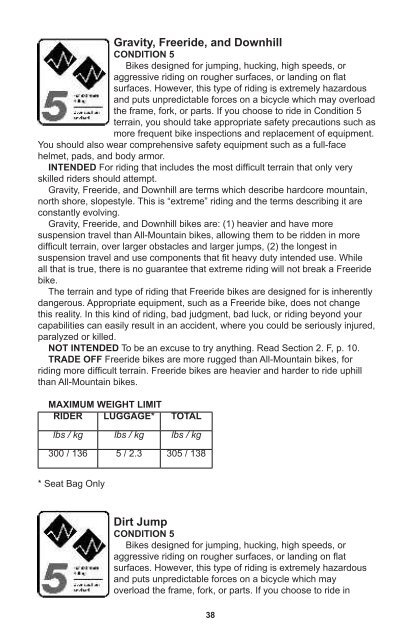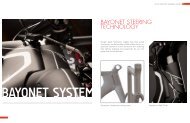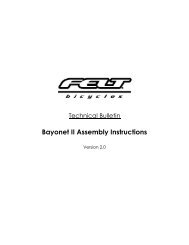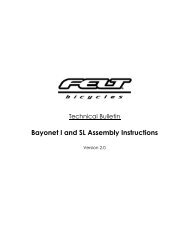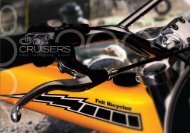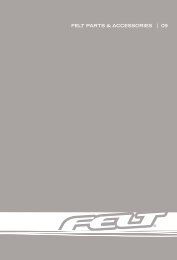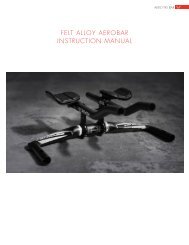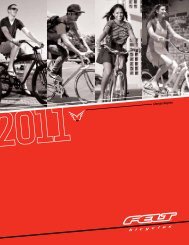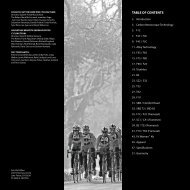Bicycle Owners Manual - Felt Bicycles
Bicycle Owners Manual - Felt Bicycles
Bicycle Owners Manual - Felt Bicycles
You also want an ePaper? Increase the reach of your titles
YUMPU automatically turns print PDFs into web optimized ePapers that Google loves.
Gravity, Freeride, and Downhill<br />
CONDITION 5<br />
Bikes designed for jumping, hucking, high speeds, or<br />
aggressive riding on rougher surfaces, or landing on flat<br />
surfaces. However, this type of riding is extremely hazardous<br />
and puts unpredictable forces on a bicycle which may overload<br />
the frame, fork, or parts. If you choose to ride in Condition 5<br />
terrain, you should take appropriate safety precautions such as<br />
more frequent bike inspections and replacement of equipment.<br />
You should also wear comprehensive safety equipment such as a full-face<br />
helmet, pads, and body armor.<br />
INTENDED For riding that includes the most difficult terrain that only very<br />
skilled riders should attempt.<br />
Gravity, Freeride, and Downhill are terms which describe hardcore mountain,<br />
north shore, slopestyle. This is “extreme” riding and the terms describing it are<br />
constantly evolving.<br />
Gravity, Freeride, and Downhill bikes are: (1) heavier and have more<br />
suspension travel than All-Mountain bikes, allowing them to be ridden in more<br />
difficult terrain, over larger obstacles and larger jumps, (2) the longest in<br />
suspension travel and use components that fit heavy duty intended use. While<br />
all that is true, there is no guarantee that extreme riding will not break a Freeride<br />
bike.<br />
The terrain and type of riding that Freeride bikes are designed for is inherently<br />
dangerous. Appropriate equipment, such as a Freeride bike, does not change<br />
this reality. In this kind of riding, bad judgment, bad luck, or riding beyond your<br />
capabilities can easily result in an accident, where you could be seriously injured,<br />
paralyzed or killed.<br />
NOT INTENDED To be an excuse to try anything. Read Section 2. F, p. 10.<br />
TRADE OFF Freeride bikes are more rugged than All-Mountain bikes, for<br />
riding more difficult terrain. Freeride bikes are heavier and harder to ride uphill<br />
than All-Mountain bikes.<br />
MAXIMUM WEIGHT LIMIT<br />
RIDER LUGGAGE* TOTAL<br />
lbs / kg lbs / kg lbs / kg<br />
300 / 136 5 / 2.3 305 / 138<br />
* Seat Bag Only<br />
Dirt Jump<br />
CONDITION 5<br />
Bikes designed for jumping, hucking, high speeds, or<br />
aggressive riding on rougher surfaces, or landing on flat<br />
surfaces. However, this type of riding is extremely hazardous<br />
and puts unpredictable forces on a bicycle which may<br />
overload the frame, fork, or parts. If you choose to ride in<br />
Condition 5 terrain, you should take appropriate safety precautions such as more<br />
frequent bike inspections and replacement of equipment. You should also wear<br />
comprehensive safety equipment such as a full-face helmet, pads, and body<br />
armor.<br />
INTENDED For man-made dirt jumps, ramps, skate parks other predictable<br />
obstacles and terrain where riders need and use skill and bike control, rather<br />
than suspension. Dirt Jumping bikes are used much like heavy duty BMX bikes.<br />
A Dirt Jumping bike does not give you skills to jump. Read Section 2. F, p. 10.<br />
NOT INTENDED For terrain, drop offs or landings where large amounts of<br />
suspension travel are needed to help absorb the shock of landing and help<br />
maintain control.<br />
TRADE OFF Dirt Jumping bikes are lighter and more nimble than Freeride<br />
bikes, but they have no rear suspension and the suspension travel in the front is<br />
much shorter.<br />
MAXIMUM WEIGHT LIMIT<br />
RIDER LUGGAGE TOTAL<br />
lbs / kg lbs / kg lbs / kg<br />
300 / 136 0 300 / 136<br />
Cyclo-cross<br />
CONDITION 2<br />
Bikes designed for riding Condition 1, plus smooth gravel<br />
roads and improved trails with moderate grades where the<br />
tires do not lose ground contact.<br />
INTENDED For cyclo-cross riding, training and racing.<br />
Cyclo-cross involves riding on a variety of terrain and surfaces<br />
including dirt or mud surfaces. Cyclo-cross bikes also work<br />
well for all weather rough road riding and commuting.<br />
NOT INTENDED For off road or mountain bike use, or jumping. Cyclo-cross<br />
riders and racers dismount before reaching an obstacle, carry their bike over<br />
the obstacle and then remount. Cyclo-cross bikes are not intended for mountain<br />
bike use. The relatively large road bike size wheels are faster than the smaller<br />
mountain bike wheels, but not as strong.<br />
MAXIMUM WEIGHT LIMIT<br />
RIDER LUGGAGE TOTAL<br />
lbs / kg lbs / kg lbs / kg<br />
300 / 136 30 / 13.6 330 / 150<br />
38 39


